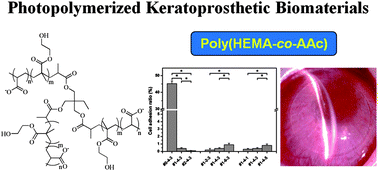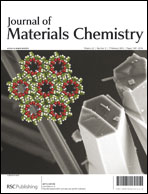Development of functional hydrogels for use in anterior lamellar keratoplasty can potentially eliminate the risk of corneal endothelial rejection associated with penetrating keratoplasty. This study aims to copolymerize 2-hydroxyethyl methacrylate (HEMA) with acrylic acid (AAc) to fabricate a transparent, bioinert keratoprosthesis base material that evokes minimal ocular cell/tissue response and suppresses corneal epithelial cell attachment and growth. In the presence of varying amounts of monomers (i.e., 72–92% HEMA and 0–20% AAc), initiators (i.e., 2–6% 2,2-diethoxyacetophenone (DEAP)), and cross-linkers (i.e., 2–6% trimethylolpropane trimethacrylate (TMPTMA)), the photopolymerized samples were synthesized successfully by varying reaction time (i.e., 10–50 min), and were characterized by Fourier transform infrared spectroscopy and contact angle measurements. While the introduction of PAAc into the structure of PHEMA can enhance the water content and oxygen and nutrient permeability, it simultaneously reduces mechanical and suture strength as well as resists protein adsorption and cell adhesion. For an incomplete cross-linked hydrogel prepared with lowest DEAP and TMPTMA content or least UV irradiation time, significant cytotoxicity and inflammation were noted, probably due to the presence of more unreacted C![[double bond, length as m-dash]](https://www.rsc.org/images/entities/char_e001.gif) C bonds. The in vitro and in vivo studies showed that the membranes obtained from optimized photopolymerization conditions had good compatibility with the corneal epithelial cell cultures and the anterior segment of the eye. Additionally, the properties of this poly(HEMA-co-AAc) material were comparable to those of native corneas, suggesting that it may be a promising candidate for direct application in artificial cornea or further surface functionalization during keratoprosthesis design.
C bonds. The in vitro and in vivo studies showed that the membranes obtained from optimized photopolymerization conditions had good compatibility with the corneal epithelial cell cultures and the anterior segment of the eye. Additionally, the properties of this poly(HEMA-co-AAc) material were comparable to those of native corneas, suggesting that it may be a promising candidate for direct application in artificial cornea or further surface functionalization during keratoprosthesis design.

You have access to this article
 Please wait while we load your content...
Something went wrong. Try again?
Please wait while we load your content...
Something went wrong. Try again?
![[double bond, length as m-dash]](https://www.rsc.org/images/entities/char_e001.gif) C bonds. The in vitro and in vivo studies showed that the membranes obtained from optimized photopolymerization conditions had good compatibility with the corneal epithelial cell cultures and the anterior segment of the eye. Additionally, the properties of this poly(HEMA-co-AAc) material were comparable to those of native corneas, suggesting that it may be a promising candidate for direct application in artificial cornea or further surface functionalization during keratoprosthesis design.
C bonds. The in vitro and in vivo studies showed that the membranes obtained from optimized photopolymerization conditions had good compatibility with the corneal epithelial cell cultures and the anterior segment of the eye. Additionally, the properties of this poly(HEMA-co-AAc) material were comparable to those of native corneas, suggesting that it may be a promising candidate for direct application in artificial cornea or further surface functionalization during keratoprosthesis design.

 Please wait while we load your content...
Please wait while we load your content...